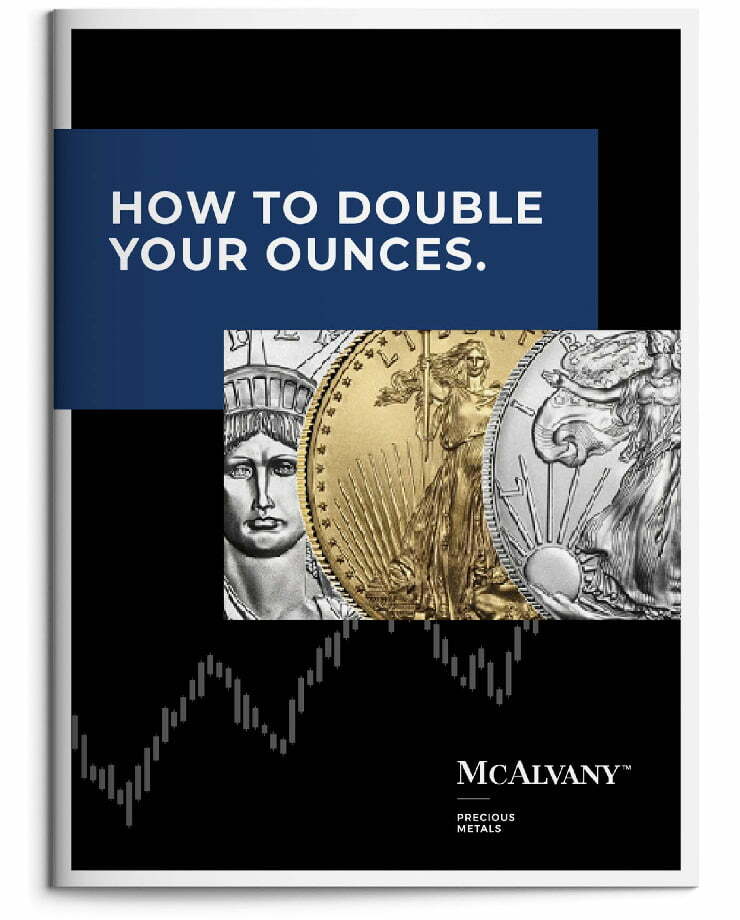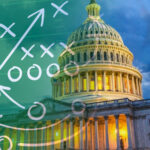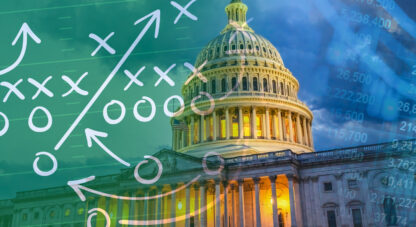For over a year, HAI has considered the Federal Reserve’s interest rate policy to be broken. That’s because the Fed is largely boxed in by the twin nemeses of inflation and a U.S. government debt and deficit crisis.
The Fed seemingly can’t keep rates steady or even raise rates further to effectively fight inflation because of the resulting increase in interest expenses that would threaten to blow out the deficit and trigger a debt spiral. On the other hand, the Fed can’t cut rates to ease the debt and deficit problem without stoking the inflation fire with some extra gas.
In fact, in HAI’s view, the Fed’s quagmire was confirmed several weeks ago when, referring to the Federal Reserve being trapped between “higher inflation” and “huge deficits,” JPMorgan CEO Jamie Dimon told shareholders at the annual meeting, “You all think [the Fed] can manage all this. I don’t think they can.”
In the last week we’ve witnessed the overwhelming force of a coordinated Trump administration messaging campaign to pressure Fed Chair Powell to cut interest rates or completely discredit him if he doesn’t.
First it was President Trump with this gentle nudge, “tweeting” on X that, “’Too Late’ Jerome Powell is costing our Country Hundreds of Billions of Dollars. He is truly one of the dumbest, and most destructive, people in Government, and the Fed Board is complicit… TOO LATE’s an American Disgrace!”
Then there was also this gem from President Trump: “‘Too Late’ Powell… could do the biggest and best job for our Country by helping to lower interest Rates and, if he reduced them to the number they should be, 1% to 2%, [a far cry from the current 4.25-4.50 range of the current Fed Funds Rate] that ‘numbskull’ would be saving the United States of America up to $1 Trillion Dollars per year… If he was concerned about inflation or anything else, then all he has to do is bring the Rate down, so we can benefit on Interest Costs, and raise it in the future when and if these other elements happen (which I doubt they will!)… I don’t know why the Board doesn’t override this Total and Complete Moron!”
Then last Wednesday, Trump was at the NATO summit in The Hague, Netherlands, lobbing his latest attacks on a man he had nominated for the Fed job nearly eight years ago. When asked about Powell, Trump said, “I think he’s terrible.” Then added, he’s a “very average mentally person,” with “a low IQ for what he does… I think he is a very stupid person, actually.”
Next it was William Pulte, Director of the Federal Housing Finance Agency (FHFA), that took his shot. Pulte Tweeted that “Jerome Powell is a main reason for the Housing Supply Crisis in this Country. By improperly keeping interest rates high, Jerome Powell is… directly fueling the housing supply crisis. He must lower rates.”
Then Secretary of Commerce Howard Lutnick was up next in the Twitter queue, saying, “Our Federal Reserve Chair is obviously afraid of his own shadow… These high interest Rates make no sense. Enough is enough!!!” Later in the week Lutnick added, “Jerome Powell—your job is to help Americans not hurt them, so do your job and CUT our absurdly high Interest rates at your next meeting.”
Lastly, late last week, Vice-President JD Vance jumped into the feeding frenzy on Powell saying, “I’d love to hear an argument for why Powell cut rates 50 points right before the election but can’t do it now with inflation lower.”
Not to take sides in this rather one-sided spat (those pre-election rate cuts don’t look great right now), but Powell does have an argument. Inflation continues to run above the Fed’s official 2% target for the 52nd consecutive month (four years and three months), and the Goldman Sachs’ economics team just forecast that new tariffs will increase inflation by the end of this year to about 3.5% in terms of core PCE and from 2.5% to roughly 4% for CPI. Deficit reduction isn’t an official Fed mandate, but maintaining stable prices (close to 2%) most certainly is.
Given the longstanding tradition and expectation of Fed independence along with the mandate of price stability, HAI believes Powell’s reluctance to cut rates now is very defensible. That said, these are not “normal” times and we’re not in Kansas anymore. The deficit problem is very real, and the interest component has us flirting all too closely with a full-on debt spiral.
When we put the administration’s pressure tactics in the context of Jamie Dimon’s comments about the Fed not being able to “handle this” and the U.S. debt, deficit, and fiscal situation more broadly, HAI starts to get the feeling that this administration is beginning to panic over the implications of soaring interest expenses.
Furthermore, HAI continues to think that the balance of evidence suggests this administration has already made its choice. Given the Fed’s predicament of being unable to cut rates due to inflation but needing to cut due to the interest impact on the deficit—this administration is clearly choosing their preference—the route of higher inflation. And they’re willing to force the issue.
After all, as Albert Einstein said, “compounding interest is the eighth wonder of the world,” and it’s probably toppled more empires than all of history’s warlords combined. This time, compound interest is working to greatly compound the U.S. debt and deficit problem and take down the American empire at the knees.
In this uncharted territory, it seems new rules are replacing old. Clearly, Fed independence is out with the old, and Trump is reportedly already champing at the bit to replace Powell next Spring with a new Fed Chair sympathetic to his aggressive rate cut desires. Similarly, it appears that the Fed’s dual mandate of full-employment and price stability is also a de facto casualty of the new rules. It seems clear that, in the mind of the President, the new Fed mandate is to keep the government solvent!
That means significantly weakening the U.S. dollar, financially repressing U.S. Treasury holders with significantly negative real yields, and inflating down U.S. debt-to-GDP by hook or by crook.
Now, while that new Fed mandate may not be at all good for the purchasing power of the U.S. dollar or the real value of U.S. Treasuries, it is certainly good for higher gold prices—and HAI expects just that!
Weekly performance: The S&P 500 was up 3.44%. Gold was down 2.83%, silver was off 0.08%, platinum was up 6.28%, and palladium was up 7.68%. The HUI gold miners index was off 3.45%. The IFRA iShares US Infrastructure ETF was down 3.15%. Energy commodities were volatile and lower on the week. WTI crude oil was down 12.12%, while natural gas was off 3.85%. The CRB Commodity Index was down 4.09%. Copper was up 5.02%. The Dow Jones US Specialty Real Estate Investment Trust Index was off 1.33%. The Vanguard Utilities ETF was up 1.35%. The dollar index was off 1.54% to close the week at 97.19. The yield on the 10-yr U.S. Treasury was off 10 bps to close at 4.28%.
Best Regards,
Morgan Lewis
Investment Strategist & Co-Portfolio Manager
MWM LLC















